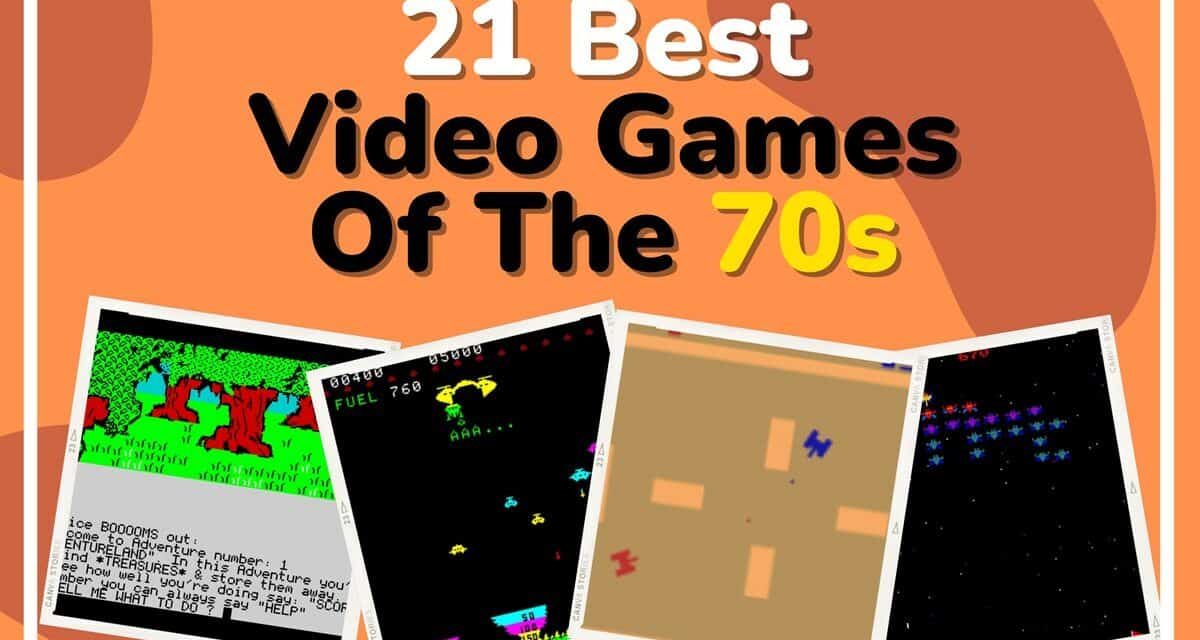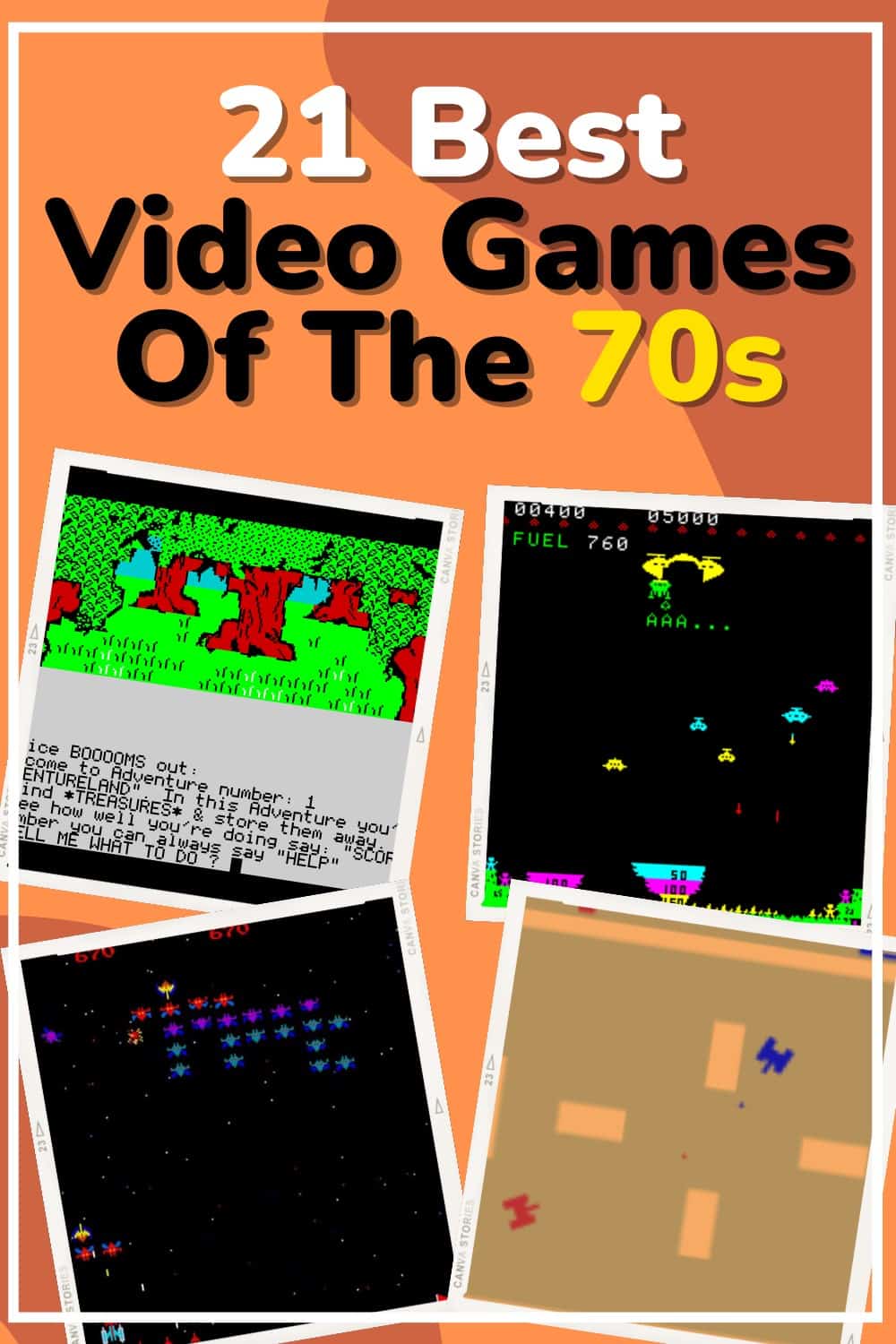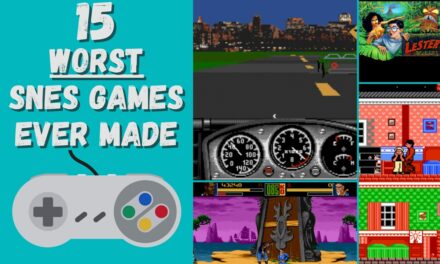Before hyper-realistic graphics, high fps rates, the incredible power of Ray Tracing, and other technological wonders that have taken video games to another level, there was a time when flared pants, outfits with prints of various shapes and colors, and of course, long hair shone.
That’s right, we are talking about the magical 70s.
But beyond the fashion trends and social movements of that decade, there was an important evolution in video games both in the arcade and home.
While the first game in history dates back to 1952, it wasn’t until the 70s arcades that video games were mass-produced, with the successful launch of Pong, Space Invaders, and the birth of Atari.
As history has shown, Atari was the king of home console gaming in the 70s, but it had its competitors that released some of the best games of that decade. They may look very old and archaic, but they were epoch-making and are still enjoyable today. These are the
Best Video Games Of The 1970s
Blasto (1978)
- Publisher: Gremlin
- Platforms: Arcade, TI-99/4A
- Genre: Action, Puzzle
We start with a great game that is still a lot of fun today but whose sales were hurt by the first place in this ranking. We leave you with that intrigue.
Blasto is a video game for 1 or 2 players. The objective is very simple: shoot all the mines on the stage in less than 90 seconds. If the player achieves this feat, he will be rewarded with another round.
For this mission, we have a futuristic spaceship (you will see similar games with this theme in the list) with which we travel through a dangerous maze of mines.
You have to be careful and shoot the mines from a safe distance because each one has a specific range of explosion that can end your journey in an instant, but that shockwave can also play in our favor if it reaches other mines.
Graphically it is very simple like most games of the era. With a two-color graphic palette, a small spacecraft, squares, and targets, you can get a highly addictive video game.
It was not the most cutting edge of 1978, but it was one of the most practical and addictive video games.
FS1 Flight Simulator (1979)
- Publisher: Sublogic
- Platforms: PC
- Genre: Amateur flight simulator
Released in the last month of the decade for the Apple II, Flight Simulator is the first game of the famous Microsoft franchise of realistic plane flights, although it was not until 1982 that they began to market it under their label.
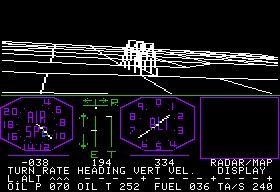
The game offers vector graphics that require a lot of imagination to recreate the exterior view but still convey the feeling of flight and movement that PCs of the time could offer.
You only have one plane and one region: a 6×6 grid with mountains. The player can press “W” and “declare war”, entering a WWI mode. The objective is to shoot down enemy planes and bomb their base.
It is very archaic and perhaps unplayable for many people nowadays, but it laid the foundations of Microsoft Flight Simulator, a series that is not exactly considered gaming, but experiences so realistic that make you feel like a professional pilot.
Adventureland (1978)
- Publisher: Creative Computing Software
- Platforms: PC
- Genre: Interactive Fiction
As the first text-based game for home computers, Adventureland was the adventure game that started the Adventure genre and brought fame to its creator, Scott Adams, a programmer you may not have heard of today but who worked on dozens of important games of the 1970s.
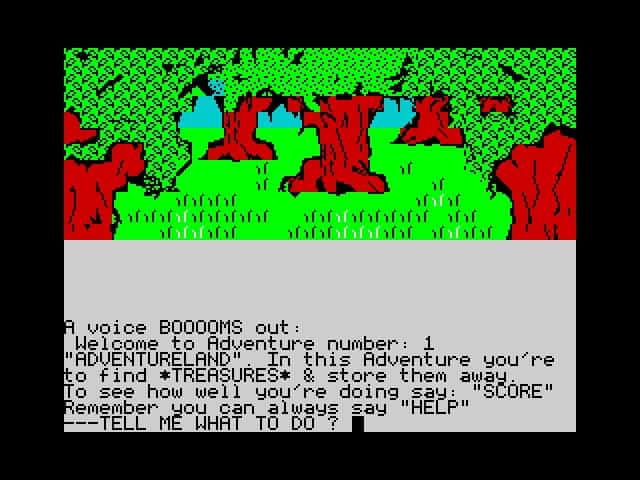
The plot centers on a quest for 13 powerful artifacts in a fantasy world… of text, so your imagination will determine your experience.
The character is controlled using one-word typed commands. For example, to move, you must use the cardinal directions and up and down. Or if the adventure requires it, you must write two-word phrases such as “Climb tree”.
With over 120 words recognizable to the system, you must collect 13 magical artifacts, such as a dragon egg, a golden fish, a magic carpet, and more.
Adventureland was not a very successful release, but it was enough to start a whole series and be re-released in 1982 with graphics that allow you to visualize the scenery and objects.
M-79 Ambush (1977)
- Publisher: Ramtek
- Platforms: Arcade
- Genre: Shooter
This war game is neither the most entertaining nor the most original, but it brought with it some technical implementations that make it worthy of a place on this list.
With a couple of guns as controls in the arcade, which you can play alone or with a friend, M-79 Ambush consists of shooting at various targets such as tanks, jeeps, and helicopters that move horizontally across the screen.
The difficulty lies in calculating the trajectory of your grenade launcher, as it has realistic mechanics that simulate a real shot. Beyond this, the gameplay doesn’t have much more to offer, but the title stands out for being the first to use a Micro Processor to control the game.
In addition, M-79 Ambush had a small frame memory that scanned the images as contemporary televisions do. Undoubtedly, a feat ahead of its time.
Lunar Rescue (1979)
- Publisher: Taito
- Platforms: Arcade
- Genre: Action
As a combination of Taito’s own Space Invaders and Atari’s Lunar Lander, Lunar Rescue hit the markets to offer an innovative experience but tanked in sales because it coincided with such a game about asteroids.
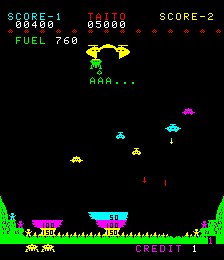
Your goal in Lunar Rescue is to rescue six astronauts trapped on the lunar surface with the help of a module, controlling their descent speed until they manage to get down to the surface.
It was the first game to feature two screens, one for descent and one for ascent. You have three lives to score as many points as possible and can play one or two players.
The gameplay is very simple (left/right + a fuel/shoot button) and is quite well-adjusted. The difficulty curve is very gradual along with the different tasks to be performed, so we get a good gaming experience.
It’s a pity that a game as competent as Lunar Rescue has been lost in time, although a small but loyal fan base remembers it fondly.
Sargon (1978)
- Developers: Dan Spracklen and Kathleen Spracklen
- Platforms: PC
- Genre: Chess
You may be wondering why a traditional game like chess appears on this list. And the feat of its creators was precisely that, to adapt such a classical game as chess to electronic devices comfortably and efficiently, with a challenging artificial intelligence.
To create Sargon, the Spracklen programmers used a BASIC listing of an unfinished chess program that fell into their hands. With appropriate modifications and a microprocessor new for the time, they created the first version of the program in 1978, which won the first chess tournament for home computers at the West Coast Computer Faire.
Sargon quickly spread to other machines, while the Spracklen’s continued to release new versions that improved the complexity of the program and added various features such as a catalog of chess openings.
We must not forget that there are millions of gamers dedicated to chess on pages like Chess.com, Chess24, or Lichess, whose precursor is Spracklen’s Sargon system, a program that proved that machines could challenge a human in the intellectual field.
Mattel Auto Race (1976)
- Publisher: Mattel
- Platforms: Handheld
- Genre: Racing
The first completely portable video game in history. In a small device with a few driving buttons and the on/off switch, some LED lights, and a sound system consisting of a few beeps, Mattel Auto Race marked history in the industry.
Of course, the game required a lot of imagination because of its format, with very simple graphics of geometric figures representing the car.
The goal is to reach the top of the track vertically while racing against other drivers. And that was all, 99 seconds full of adrenaline that today we see it too old-fashioned, but for the time it was hilarious, so much so that Mattel launched another portable video game about Football shortly after.
But not only Mattel took advantage of this handheld, other companies began to see the enormous potential that video games in portable format had, only the console was missing.
Night Driver (1976)
- Publisher: Atari
- Platforms: Arcade, Atari 2600
- Genre: Racing
At the end of 1976, Atari released one of the most original and complete video games of the year and adapted the technical limitations imposed by technology to the realism of driving at night on a road without lights in a masterful way. This game is Night Driver.

With its first-person perspective, we can be talking about the first driving simulator ever created, and it is quite realistic for the technical limitations it had.
As for the premise, it is very straightforward. You have to drive down a long track being careful not to drive off the road. When the 99 seconds run out, the game ends and your score is the distance you managed to drive.
For the time, the graphics are well done along with the feeling of speed, which is similar to current video games, which increase the frequency of the signals that limit the track.
With a realistic sound design and excellent gameplay, Night Driver is one of the most addictive video games of that decade, something that motivated other companies to copy its formula and launch their own driving simulator games, such as “Datsun 280 ZZZAP” by Midway Games.
Computer Space (1971)
- Publisher: Nutting Associates
- Platforms: Arcade
- Genre: Shoot’em Up
We continue with another video game that changed the industry, but this one did it more radically.
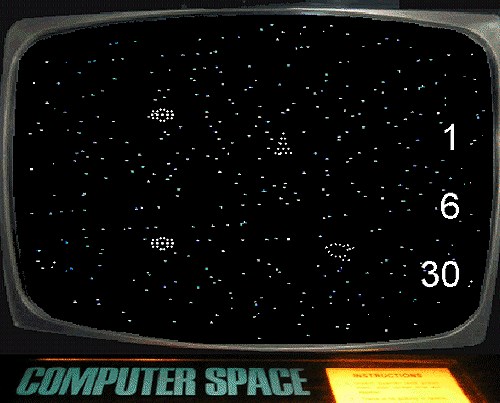
Created by Nolan Bushnell and Ted Dabney, the founders of Atari, Computer Space is considered the first arcade video game that worked with coins.
Precursor of the legendary Asteroids, this title consists of controlling a rocket that fights against flying saucers (they really had a craze for that in the 70s).
Throughout the game, you have unlimited lives, but you have a time limit of 100 seconds, with a counter of lives lost and alien ships destroyed. This mechanic is repeated indefinitely as long as your score is higher than the number of Martians on the screen.
Games without limit, are another quality of those golden years. But Computer Space was too innovative at its launch, as it was too complicated for casual gamers, so it didn’t sell as many units as planned.
Despite that, today it is remembered as the title that laid the foundations of the Shoot ’em Up genre, which was the arcade sensation.
Gun Fight (1975)
- Publisher: Midway
- Platforms: Arcade, Astrocade, Atari 8-bit
- Genre: Shooter
Mortal Kombat may be the game that sparked the creation of the age rating in the gaming market, but the first game that dared to depict graphic violence was Gun Fight.

Also known as Western Gun in Japan and Europe, in this game you take control of a cowboy of the Wild West, who must fight a duel against various bandits and gunmen. This theme made it the first game that let you shoot humans.
The gameplay as such is very similar to Pong, only here, instead of hitting the ball, you have to avoid being hit and hit at the same time at your opponent.
In addition, you have much more freedom of movement, you can move up and down, left and right, and aim the shot up, center, or down.
The bullet bounces off the top and bottom of the screen (like in Pong). You have six shots per point, which are renewed when a cowboy falls, and a 60-second counter that will mark the total duration of the game.
Gun Fight was a revolution for the time, bringing new concepts to the industry that stayed forever.
The Oregon Trail (1978)
- Publisher: Brøderbund
- Platforms: PC
- Genre: Simulator
Created to educate students in the United States about the life of the pioneers on the Oregon Trail in the 19th century, this successful video game transcended its purposes to expand massively all over the world, so much so that the total sales for the series amount to more than 65 million copies sold.
But like all great franchises, it had humble beginnings. Several professors joined forces to create this simulator, in which you take control of the manager of a wagon that guides a group of settlers through the famous Oregon route, where you will encounter incredible events, despite the limitations of technology.
From managing your supplies, and hunting animals to narrative surprises based on real testimonies of the travelers of that route, this simulator is one of the most remembered of the time.
Over the years, The Oregon Trail received several improvements to make it more realistic and increase the random events the player encounters. Newer versions of the educational game are still being released to this day, educating and entertaining in equal measure.
Sea Wolf (1976)
- Publisher: Midway
- Platforms: Arcade, Commodore 64, VIC-20
- Genre: Shooter
Inspired by the name of an old U.S. nuclear submarine and featuring one of the most beautiful cabinets of the time, Sea Wolf was a huge hit for Midway, holding the position of the highest-grossing arcade video game for two years in a row.
In the game, you are in charge of firing torpedoes from the bottom of the sea to the surface to hit the ships at the top of the screen that are sailing from left to right or the other way around.
Depending on which ship you hit, you receive a certain amount of points. You have 60 seconds to shoot down the ships and get as many points as possible. But not everything will be so easy, because water mines and the reloading system will complicate your naval mission progressively.
The graphics were also one of the best at the time, as every element on the screen had a lot of detail.
Overall, Sea Wolf is one of the most fondly remembered arcade games of all time, offering a realistic experience even today. It is no surprise that some contemporary gamers still play this great game.
Combat (1977)
- Publisher: Atari
- Platforms: Atari 2600
- Genre: Shooter
If you wonder why a game as emblematic as Tank is not on this list, it is because Combat takes a lot from its formula and makes it better.
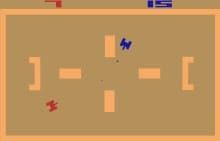
Combat is the definitive version of this genre, as it has 27 game modes, where we can control a tank, a biplane, or a fighter, depending on the mode we choose.
As for the tanks, the gameplay unfolds in various types of scenarios where you must fight against an enemy tank controlled by another player, plus you can switch shooting modes.
If you choose a biplane, the mechanics are more dynamic, since the aircraft is constantly moving, although the objective is the same, to defeat your rival.
On the other hand, the jet combat is very similar to the biplane combat, but with more options, allowing you to control the speed of your fighter and with projectiles with a longer range.
With simple but functional graphics, a variety of vehicles, and entertaining game modes, Combat is an excellent title that showed all that the Atari 2600 could offer, although the only flaw is that it can only be played with 2 players on your 2600, so you’d better make friends.
Death Race (1976)
- Publisher: Exidy
- Platforms: Arcade
- Genre: Racing
If you were thinking about it, no, we’re not talking about the 1975 movie starring Sylvester Stallone, although we have to admit that they have some similarities.
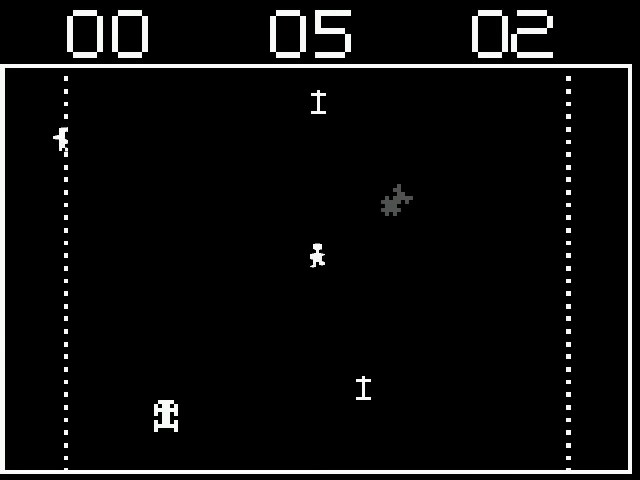
Like Gun Fight, Death Race also generated controversy at the time, let’s see why.
In this game, you are a crazy driver whose only mission is to run over “gremlins”, creatures that run away terrified from you. When they die and cause a bloodcurdling screech, their bodies transform into tombstones, something that increases the difficulty as you eliminate more gremlins, and their gravestones fill up the space on the screen.
Of course, all this was represented with simple, two-color graphics, but that didn’t stop a journalist from The Associated Press from setting her eyes on the game, giving it a bad review claiming that it encouraged violence.
Fortunately, this did not affect Death Race’s sales, quite the contrary, it was a resounding success!
Galaxian (1979)
- Publisher: Namco
- Platforms: Arcade
- Genre: Shoot’em Up
Inspired a lot by Space Invaders and even being considered by many as its spiritual successor, Galaxian is one of the best Shoot ’em Ups of the time. Moreover, it improves in all technical aspects with better graphics, sound and, if we can say so, with its brand new A.I.
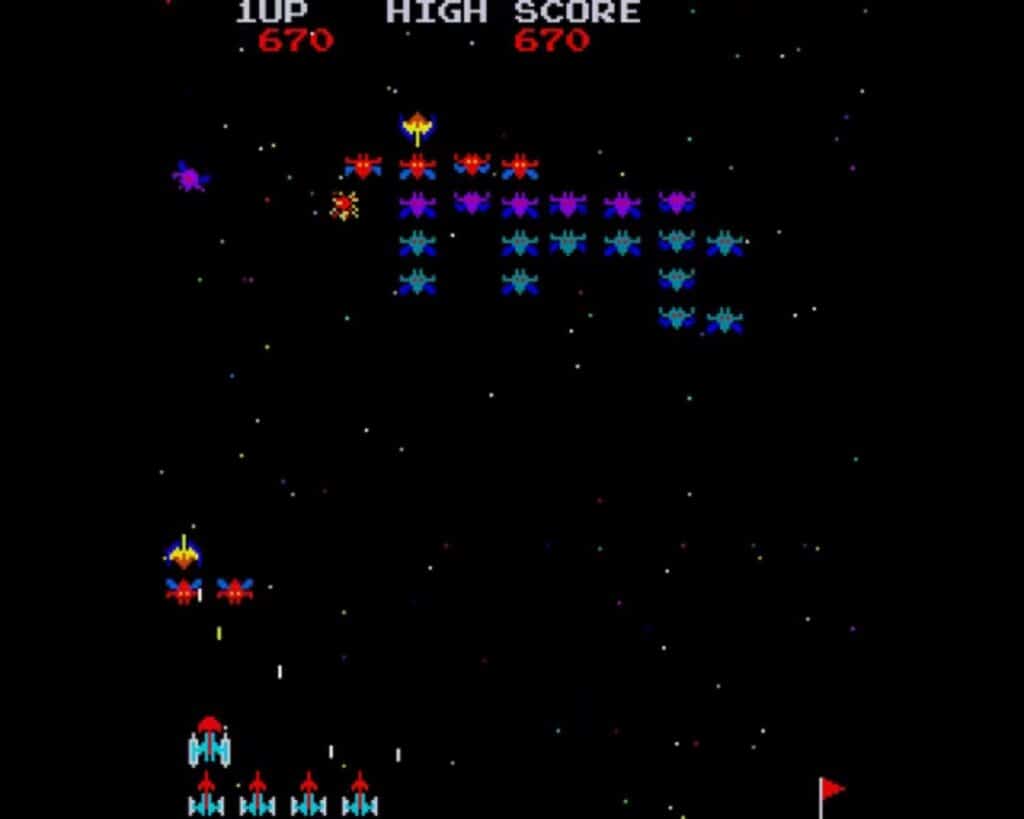
In this title, you control a spacecraft and will have to exterminate the alien hordes that want to invade our planet.
It wasn’t the first game that let you shoot down alien spacecraft, but that’s why Namco added certain dramatic touches to the gameplay, such as the enemy ships launching themselves at you like all kamikazes, breaking their characteristic formation.
Another of the most remarkable aspects was the graphics, simply spectacular… “Galaxian” was the first commercially available video game to present 100% of its graphics in true RGB. The number of elements on screen resulted in the most filling composition seen in a video game up to that time.
Indeed, Galaxian is not very original, but that was not its goal either. Its purpose was to take the genre of player vs. alien ships to another level, and boy, did it succeed. If it’s not higher at the top, it’s because the remaining positions have nostalgia on their side.
Space Wars (1977)
- Publisher: Cinematronics
- Platforms: Arcade, Vectrex
- Genre: Shooter
Space Wars is one of the oldest video games ever created, and its first version is possibly the second video game ever designed (not marketed). It was also the first video game created with vectors, and that is quite noticeable to gamers of that era.
This title is played with two players. There are two spaceships, located at opposite ends of the screen that we can control by a rotating movement and give impulse with a fuel button. Because of this, the ships have tremendously realistic control.
The other button you can use is a shot to eliminate your opponent, through a combination of aiming and speed.
In the end, the winner is the one who has obtained the most points, that is, the one who has destroyed the other one the most times. Nothing better than playing Space Wars to strengthen friendship, don’t you think?
To this day, its gameplay continues to impress due to the fluidity and smoothness of the ship’s movements, a technological feat without a doubt. Although it can get a bit repetitive after a few games, Space Wars can keep you hooked with the right buddy or group of friends.
Adventure (1979)
- Publisher: Atari
- Platforms: Atari 2600
- Genre: Adventure (surprise!)
Born as the graphic adaptation of the text video game “Colossal Cave Adventure”, this title is considered the pioneer of not only the adventure genre but of action and fantasy together, a formula that became one of the most profitable in the gaming industry.
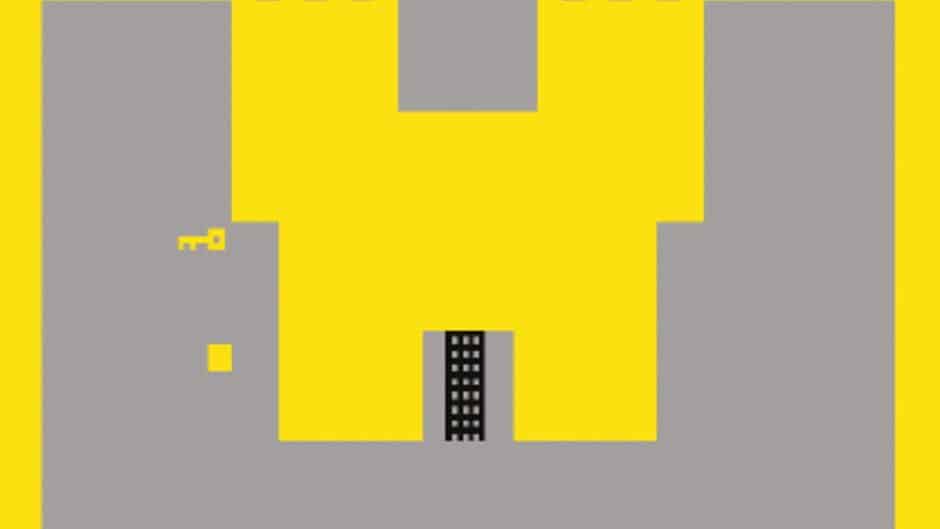
Your mission in Adventure is to find a magic chalice belonging to the golden castle. But saying it is easier than doing it, because on the way you’ll encounter annoying bats and terrible dragons that want to stop you… or eat you.
The setting of this title includes castles, labyrinths, bridges, and other scenes from a medieval story, where of course weapons and magical artifacts also have their place.
But we all know that Adventure has a main feature for which it is so well known today, and that is that it is the first video game with an easter egg in history. It turns out that at that time, Atari did not give credit to its programmers so that they would not be hired by the competition.
This generated a wave of departures in the company, but Warren Robinett, Adventure’s designer, had a different idea. Behind a virtual wall in the game, you can access a hidden room where the phrase “Created by Warren Robinett” is written, who wanted to give himself credit for creating such a gem that paved the way for many games to come.
Atari Breakout (1976)
- Publisher: Atari
- Platforms: Arcade, Atari 2600
- Genre: Created its own genre
What if you could play Pong, but by yourself?
That was the question asked by Nolan Bushnell, one of the founders of Atari, who fervently wished to repeat the successful formula of Pong but twist it. To do so, he enlisted the help of a certain Steve Jobs, who in turn enlisted the help of a certain Steve Wozniak. History always connects in curious ways.
Although the Steves’ work remained a prototype, it was enough to lay the foundations of the popular Breakout, a game with a very simple mechanic but very addictive at the same time.
The premise is to clear the bricks from the top of the screen, with the help of a ball that bounces off the walls and we can redirect with the control bar at the bottom.
In the arcades, this game was a sensation, but it was on the Atari 2600 that it shone. In that version, you can choose between 1 to 4 players, direct the ball or catch it with the bar, you can play with an invisible wall, and many more options. The best part is that all these mechanics can be combined, generating an infinite number of game modes.
It is quite incredible that such a simple video game continues to entertain to this day and has inspired many others. Breakout is proof that sometimes, less is more.
Pong (1972)
- Publisher: Atari
- Platforms: Arcade
- Genre: Sports
But if we talk about simple games, Pong takes the award. The idea of transferring the ping pong table to pixels worked wonders and this debut game became an everlasting legend.
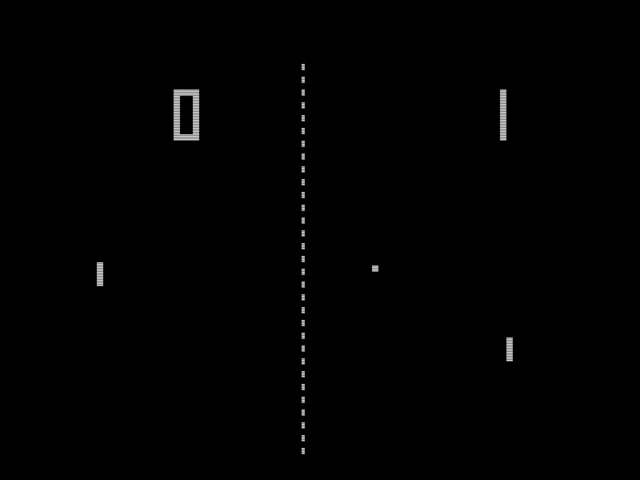
The commercial success led Atari to dominate the arcade market, while Magnavox Odyssey did the same in the home market.
Without the need for sound and with only two “rackets”, a line in between, and of course, a ball, the mechanics of Pong were more than enough to hook the players of the time for hours, or rather, Pong created the players.
No matter how many incredible graphics, immersive stories, and other wonders today’s games have, we always come back to Pong, the classic among classics and a pioneer in the video game industry. That’s why it’s quite curious that it’s a plagiarism of a Magnavox Odyssey game, but that’s a story for another day…
Although in its favor we can say that at that time, the issue of copyrights in video games was almost nonexistent, so many developers did not stop copying themselves, and so we saw countless copies of Pong.
That’s the thing about being one of the most famous video games in history.
Asteroids (1979)
- Publisher: Atari
- Platforms: Arcade
- Genre: Shooter
With more than 70,000 units sold, Asteroids was the best-selling home video game of that time, closing with a golden clasp some years of great growth for Atari.

In Asteroids, you control a spaceship immersed in the middle of an asteroid field. Your spaceship has a series of features such as being able to rotate 360 degrees that we will control with the direction, a fire button, a button to move around the screen, and another button to disappear and appear at another point of the screen with the dangers that this entails.
The gameplay is made even more entertaining with the presence of a table of 10 high scores, encouraging competitiveness among gamers. Nowadays all games have this feature, but this was revolutionary at its launch.
With simple but remarkable graphics, well-animated and realistic movements, immersive sound design, and addictive gameplay, Asteroids is a jewel of the gaming industry, catapulting the business into space.
Space Invaders (1978)
- Publisher: Midway
- Platforms: Arcade
- Genre: Shoot’em Up
But unsurprisingly, the crown jewel of 70’s video games is Space Invaders, a game that may seem simple to contemporary gamers, but it was a precursor of modern video games and helped expand the global industry to levels that even the creators themselves didn’t think possible.
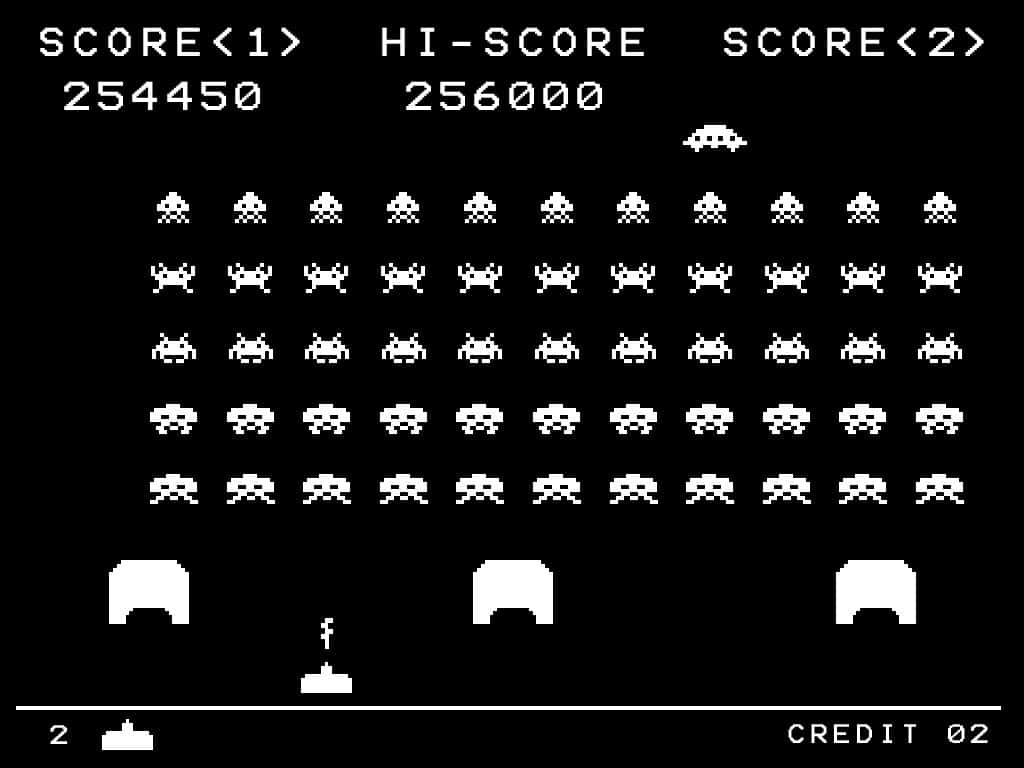
Space Invaders had been released earlier in Japan by the Taito company and was so popular, that it had caused the Japanese government to increase the production of coins due to the shortage (they were all in the boxes of the arcade machines).
The first game to feature a continuous background soundtrack, your mission is to prevent the hordes of space invaders, arranged in 5 rows of 11 aliens each, from reaching the bottom of the screen.
To do this, you have a device equipped with a laser (called “laser base” in the game) with which you can move horizontally along the entire screen to eliminate all the aliens as they descend. As you eliminate the different types of enemy ships, the others will approach faster, progressively increasing the difficulty.
With that premise, it not only hooked millions of people at the time but was the inspiration for many video games and even genres of the future.
Since Space Invaders, the history of video games had a turning point and changed completely. It is one of the most influential video games of all time and forced big companies to look at the gaming industry as a very lucrative one.
And so we end this look back at the best video game of the 1970s. Full of passion for retro and historical facts that are still relevant today.
Franchises like Mario Bros, Final Fantasy, Metal Gear Solid, and many more evolved from the successful era of the ’70s, with its incredible Shoot ’em Ups, fast cars, and above all, tons of coins spent in the arcades.
